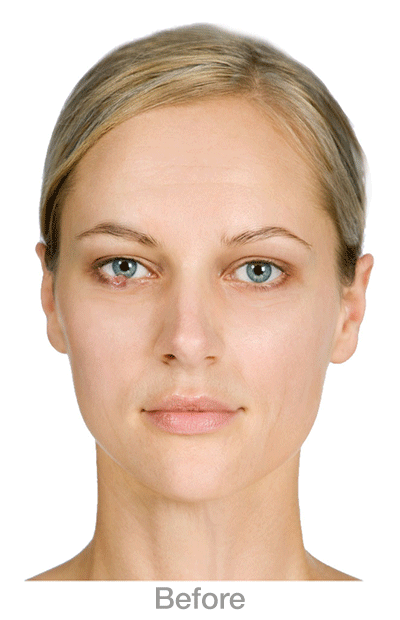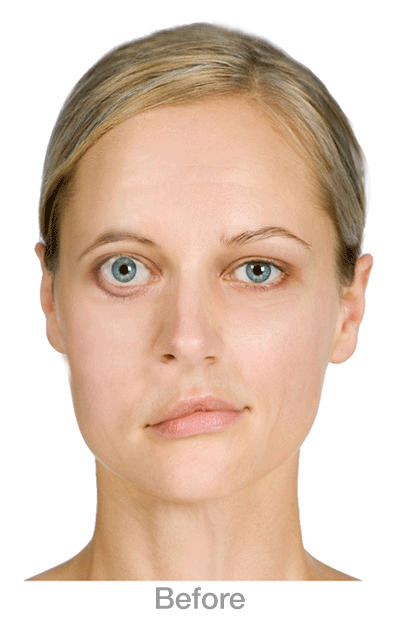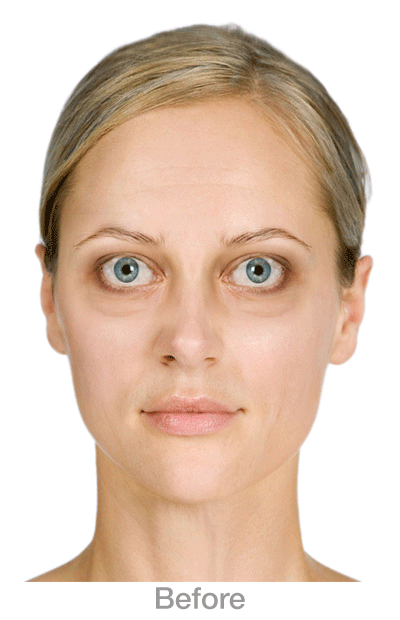Skin Cancer
Eyelid malignancies account for approximately 10% of all skin cancers. Although they are seldom fatal, they can lead to significant tissue damage and may spread to other orbital and facial structures. Eyelid cancers are most prevalent in light-skinned individuals who have experienced significant sun exposure over time, and they also occur most frequently on the lower eyelid. Basal cell carcinomas account for approximately 90% of all eyelid cancer cases, Squamous cell carcinomas occur approximately 5% of the time and melanoma, one of the most dangerous forms, accounts for approximately 1-2% of cases. Other rare carcinomas such as sebaceous cell and Merkel cell are also possible in the eye area.
Basal cell carcinoma (BCC) develops in the basal cells within the epidermis (top layer) of the skin. Basal cell carcinoma is the most common type of skin cancer of the eyelids and accounts for approximately 90% of all eyelid cancer cases. The most prevalent cause of basal cell carcinoma is prolonged exposure to UV rays of the sun. They usually develop as small, firm, painless nodules with a smooth, pearly appearance. They may also develop telangiectasia (a reddish color as a result of dilated capillaries).
Basal cell carcinomas rarely metastasize to lymph nodes or distant organs, but they are still considered malignant. If they are not detected and treated early, then they can cause local destruction of surrounding tissues including the eye, the orbital cavity and the nasal cavity. Basal cell carcinomas are often treated by removing the tumor via Mohs micrographic surgery. Based on the size of the excision, scars are minimized via reconstruction of the affected area.
Squamous cell carcinoma is a more aggressive form of skin cancer that develops in the squamous cells of the epidermis (top layer of the skin). Squamous cell carcinomas occur most frequently in areas that are subjected to prolonged exposure to the sun's harmful UV rays. In the eye area, squamous cell carcinomas usually occur on the eyelids and look like raised, scaly patches of reddened skin that may resemble a scab that does not heal. They are more dangerous than basal cell carcinomas in that they can metastasize to lymph nodes and distant organs, so early detection and treatment is important. If a squamous cell carcinoma develops, then removal of the tumor and the surrounding tissues via Mohs micrographic surgery is the primary treatment.
Melanoma is a more serious type of skin cancer because it often metastasizes to lymph nodes and distant organs versus other types of skin cancer. Melanoma begins in melanocytes, the cells that produce pigment in the skin, eyes and hair. While melanoma can occur in any area where melanocytes are found, most melanocytes are present in the skin, making it the most common form of the disease. Early detection of melanoma is important, as the survival rate is very high if detected before it spreads to other organs. Once detected, a team of doctors will work with you to determine the best course of treatment. For more information, go to www.melanoma.org.
Sebaceous cell carcinoma is a rare form of cancer of the eyelids often mistaken for benign conditions such as a sty or chalazion (a small bump on the eyelid caused by a blockage of an oil gland), as the tumors originate from the glands in the eyelid that produce the oily layer of tears. Any "sty" or chalazion that does not resolve within several weeks to months must be evaluated to rule out a possible sebaceous cell carcinoma. The treatment consists of surgical removal and monitoring to ensure distant metastasis does not occur.
Merkel cell carcinoma or MCC is a rare but aggressive skin cancer that arises from the uncontrolled growth of Merkel cells in the skin. . MCC has the potential to be lethal, and thus prompt, aggressive treatment is important. For more information, go to www.merkelcell.org.
As an ophthalmologist and oculoplastic surgeon, Dr, Elahi specializes in detecting and treating cancers surrounding the eye area. He also works closely with a team of highly regarded dermatologic surgeons, oncologists and other surgeons when more aggressive treatments are indicated.
Facial Nerve Palsy
What is Facial Nerve Palsy?
Facial Nerve Palsy, also known as seventh cranial nerve palsy, mononeuropathy VII, facial nerve paralysis or facial neuropathy, occurs when the seventh cranial (facial) nerve, responsible for controlling muscle movements of the face, is damaged. Damage to the seventh cranial nerve may also affect the sense of taste and feeling within the ear canal. A common form of facial nerve palsy is Bell's palsy which can lead to temporary or permanent paralysis of usually one side of the face.
What are the symptoms of Facial Nerve and Bell's Palsy?
When facial nerve palsy or Bell's palsy occurs, the following symptoms, among others, may exist:
• Facial droop
• Paralysis on one side of the face
• ifficulty closing the eye on the affected side
• Droopy eyelid and/or mouth
• Droopy brow
• Dry eye
• Excessive tearing
• Difficulty producing facial expressions
• Difficulty eating and drinking
• Impaired sense of taste
• Sensitivity to sound
What causes Facial Nerve and Bell's Palsy?
The cause of Bell's palsy is unknown, but facial nerve palsy can occur as a result of:
• Tumors that put pressure on the seventh cranial nerve
• Facial trauma or surgery
• Infections such as Lyme disease, HIV, tuberculosis, mononucleosis, and mumps, and other viral infections such as herpes simplex virus
• Diabetes
• Neurological disorders such as multiple sclerosis or myasthenia gravis
What functional and aesthetic changes occur with Facial Nerve and Bell's Palsy?
The extent of functional and aesthetic changes depends upon the severity of the facial paralysis. In the eye area of the affected side, often the eyebrow droops and an inability to close the eyelid known as lagophthalmos or lid lag exists, which may lead to dry eye symptoms and corneal damage if not treated. Also, an outward turning and drooping of the lower eyelid called ectropion may occur. Other facial changes such as brow droop, facial asymmetry, mid-face droop, a lop-sided smile and lower lip droop may occur.
What are my options to correct the functional and aesthetic effects of Facial Nerve and Bell's Palsy?
Any of the following procedures may be recommended for symptoms associated with facial nerve and Bell's palsy:
• Eyebrow droop: a browlift to reposition the eyebrows and recreate symmetry
• Inability to close the eyelid: a gold or platinum weight implanted under the muscle in the upper eyelid to help with upper eyelid closure
• Ectropion: tightening and repositioning of the lower eyelid
• Mid-face droop: mid-face lift to re-create facial symmetry
• Lop-sided smile: static or dynamic sling or re-animation procedures
Treatment of facial nerve and Bell's palsy often takes a multi-specialty team approach. As an ophthalmologist and oculofacial surgeon, Dr. Elahi has special expertise in managing the ophthalmic symptoms as well as the facial surgery needs that may exist. He also works closely with a team of highly specialized otolaryngologists, neurologists and physical therapists to manage other functional and aesthetic challenges of facial nerve and Bell's palsy.
Droopy Upper Lid (Ptosis)
Ptosis is simply the medical term for “drooping” Many body parts can suffer from ptosis, but ptosis of the upper eyelids is particularly detrimental to aesthetics and can cause you to appear much older than your true age. Furthermore, upper eyelid ptosis often makes a person look fatigued or inattentive. Upper eyelid ptosis may also become more than a cosmetic issue by interfering with vision.
What are the Causes of Upper Eyelid Ptosis?
Ptosis is an age-related challenge caused by a weakening of the muscles responsible for lifting the eyelids. As a result of this weakness, either one or both of the upper eyelids droop. The degree of the droop may be mild to severe, with severe ptosis leading to functional vision loss and tension headaches from straining to raise the eyelids. While most cases of ptosis are due to the natural aging process, other causes of ptosis among adults may be: A side effect of eye surgery (i.e. cataract surgery), Graves' Disease, Diabetes, Congenital ptosis, Myasthenia gravis, Cranial nerve disorders, Stroke, Strabismus, Facial nerve disorders, Orbital disorders, Tumor, Chronic inflammation and Trauma.
What are the Conservative Treatments for Ptosis?
There are non-surgical treatments available for upper lid ptosis, but these methods are generally much less effective than surgical correction. These conservative treatments include eyedrops to raise the eyelids or even taping the upper lids to hold them open. Both of these approaches are merely temporary solutions and can cause additional problems like eye dryness and irritation.
What Surgical Treatments are Available for Ptosis?
The majority of the time, surgical correction is the definitive and most effective treatment for upper eyelid ptosis, particularly in cases of severe ptosis. The two main types of upper lid ptosis repair are the internal approach and the external approach. While the internal approach leaves no scar and carries a high success rate, not every patient is a candidate for this technique. If your ptosis is severe, you may need an external approach. This choice is best determined your surgeon based on the extent and nature of the ptosis. Ptosis repair can be performed under local anesthesia or IV sedation.
Bulging Eyes
A condition known as proptosis it is often associated with Thyroid Eye Disease (TED), also known as, Thyroid Related Ophthalmopathy, Graves' Ophthalmopathy or Graves' Orbitopathy it is an autoimmune disorder that occurs in people with thyroid dysfunction.
Several of the symptoms associated with Thyroid Eye Disease are bulging eyes (proptosis) and or eyelid retraction, abnormal blinking, dry eyes, double vision (diplopia) or vision impairment and inflammation of the orbit and its surrounding tissues.
Depending on the severity different treatment options are available to either treat individual complaints or all complaints over a series of multiple surgeries. However treatment choices greatly depends on the Thyroid levels being stabilized and the individual patients needs.
Chalazion
A chalazion is a swollen bump on the eyelid. It happens when the eyelid’s oil gland clogs up. It may start as an internal hordeolum or stye. At first, you might not know you have a chalazion as there is little or no pain. But as it grows, your eyelid may get red, swollen, and sometimes tender to touch. If the chalazion gets large, it can press on your eye and cause blurry vision. A chalazion is not usually painful. It is a bump that usually develops farther back on the eyelid than a stye. It is caused by a clogged oil gland. Rarely does it make the entire eyelid swell.





